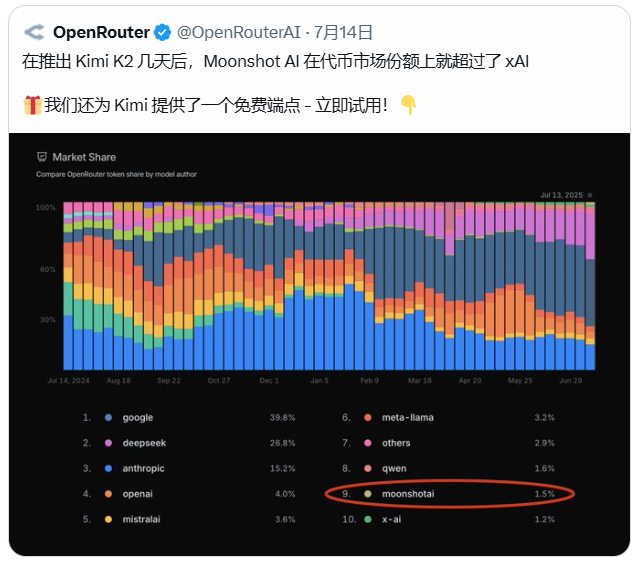Kimi K2 Surpasses xAI in OpenRouter Market Share
Kimi K2 Overtakes xAI in OpenRouter Market Share
Open-source large language model Kimi K2, developed by Chinese startup Moonshot AI, has rapidly climbed the ranks on the OpenRouter platform, surpassing both xAI's Grok4 and OpenAI's GPT-4.1 in token consumption—a key metric for market share. This surge has drawn comparisons to the "DeepSeek moment," signaling the rising prominence of open-source models in global AI competition.

The Rapid Ascent of Kimi K2
Kimi K2 is a mixture-of-experts (MoE) model with 1 trillion total parameters and 32 billion active parameters, optimized for agentic intelligence, advanced tool usage, and code generation. Within days of its release, its token consumption on OpenRouter reached 1.5%, eclipsing Grok4 and GPT-4.1. By July 14, it had risen to 13th place on OpenRouter's rankings, reflecting strong developer interest.
The model's growth is attributed to its open-source strategy and low-cost pricing. On OpenRouter, Kimi K2 charges $0.15 per million input tokens (cache hit) and $0.60 per million (cache miss), with output tokens priced at $2.50 per million—significantly cheaper than Claude4Sonnet or GPT-4.1.
Performance Highlights: Why Developers Are Switching
Kimi K2 excels in benchmark tests, particularly in:
- Coding: Achieved a 65.8% pass rate in SWE-bench Verified, nearing Claude4Sonnet's lead and far outpacing GPT-4.1 (54.6%).
- Agentic Intelligence: Supports multi-step tasks, tool calls, and complex reasoning (e.g., generating gravitational wave visualization tools from single prompts).
- Accessibility: Free weights on Hugging Face and no-subscription API access via OpenRouter or kimi.com.
Developers praise its speed and "best-in-class" emotional intelligence (EQ) in creative writing tests.
OpenRouter Market Dynamics: Kimi K2 vs. xAI
OpenRouter hosts over 400 models, including Kimi K2, Grok4, and GPT-4.1. While Grok4 initially gained attention for high benchmarks, its $300/month SuperGrok subscription and lenient content moderation have limited adoption. In contrast, Kimi K2's affordability and open-source flexibility have made it a favorite for small teams and indie developers.
One developer noted: "Kimi K2 feels like Claude3.5Sonnet's debut—its cost-performance ratio is unbeatable for production."
Industry Implications: The Open-Source Advantage
Kimi K2's success underscores the viability of open-source models in challenging proprietary giants like OpenAI and xAI. Moonshot AI’s strategy—combining free access with commercial APIs—mirrors DeepSeek’s playbook, fostering community growth while monetizing scale.
However, challenges remain:
- Occasional "hallucinations" in outputs.
- Commercial terms requiring the "Kimi K2" logo for high-traffic apps may deter some enterprises.
As adoption grows, xAI may need to rethink Grok’s pricing or differentiation to compete.
Key Points:
- 🚀 Kimi K2 surpasses Grok4/GPT-4.1 on OpenRouter with 1.5% token share.
- 💡 Strengths: Coding (65.8% SWE-bench), agentic tasks, open-source access.
- 💰 Cost edge: Input tokens at $0.15/million vs. competitors’ premium pricing.
- 🌍 Signals broader shift toward open-source AI dominance.